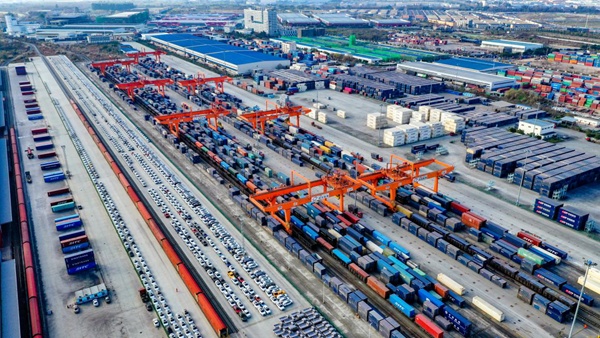Through developing multi-model international transportation and improving customs clearance efficiency, the Chengdu International Railway Port in Chengdu, southwest China’s Sichuan province, has become a platform where trade companies sell their products to more places and countries.

Chengdu International Railway Port (Photo: Publicity department of Qingbaijiang district, Chengdu)
Chengdu has seen nearly more than 2,000 trips made by China-Europe freight trains from January to December this year, according to Yang Qiling, general manager of the Chengdu International Railway Port Investment & Development (Group) Co., Ltd.
The city has a great demand for the transportation of imported and exported commodities, which tests the handling capacity of the international railway port.
In the past, the port handled 500 large containers and stored 1,000 containers at most. This year, both figures have increased thanks to the rising amount of goods needed to be transported in and out of the city.
The railway port has received significant policy support. In September 2019, it was approved to be among the first land port logistics hubs in the country. In May this year, a proposal was raised to set up an economic development zone in the area of the railway port. Three months later, the zone was approved by the Sichuan provincial government.
The maturing logistics channel, supported by the railway port, has attracted numerous foreign trade companies and platforms to areas surrounding the port.
At present, the railway port connects Chengdu with 18 domestic cities and 55 foreign cities. With seven cross-border rail routes and six cross-border sea-railway lines, it produces a foreign trade volume of $20 billion.
“Our company has delivered 330 TEUs eastward through a sea-rail transport line of the international railway port in the first half of the year,” said Yang Yong, sales director of the west region of Yusen Logistics China.
It takes 12,000 yuan ($1,836) less to have a ton of commodities transported to Japan and South Korea by the sea-rail line than by air, said Yang. Within eight days, the goods can arrive in the destination.
The railway port has carried out reform over the past few years. Chengdu International Inland Port Operations, based in the railway port, issued a combined bill of lading to a small foreign trade company, allowing the latter to use railway service documents to raise finance.
"The combined bill of lading not only helps us reduce financial pressure but also allows us to conduct more business activities," said Zhong Tao, a local businessman.


